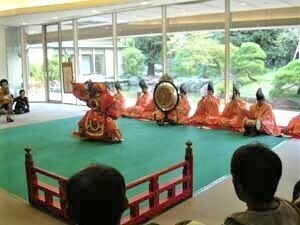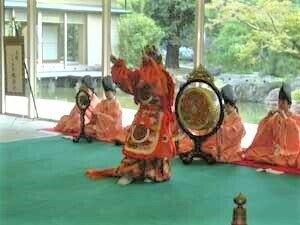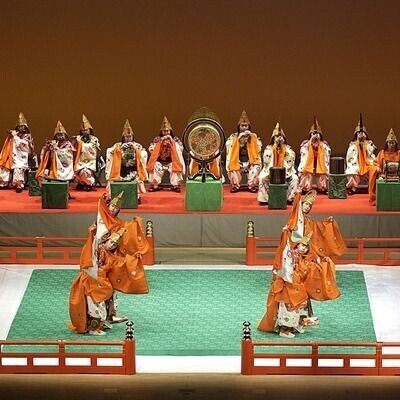
音と舞で小宇宙の世界がー The world of the microcosm with sound and dance
初めてブログを開設したのが16年前の2005年11月5日。ネットでの情報配信ツールとしてブログが人気になりかけたころ。それを使い、イベント情報や取材記事の配信を始めた。
通常の広告、宣伝、広報、イベント等々の業務に便利なツールとして活用し、個人的な活動として「心と体のなごみブログ」をスタートさせた。
The first blog was opened 16 years ago on November 5, 2005. Around the time when blogs became popular as an information distribution tool on the Internet. Using it, l started distributing event information and coverage articles.
Utilizing it as a convenient tool for normal advertising, public relations, events, etc., l started the "Mind and Body Relaxation Blog" as a personal activity.
その第一回目がタイトルにあるように「音と舞で小宇宙の世界が―」の記事。当時、知人であった京都の市比賣神社の飛騨富久宮司の影響で雅楽に興味をもち、雅楽イベントを企画。その雅楽を兵庫県西宮市の大谷美術館に提案させていただき、「雅楽会」の開催につながった。その報告としてブログを活用した。
その第一回目の記事をリライトし今回掲載させていただく。
As the first title says, the article "The world of the microcosm with sound and dance". At that time, l became interested in Gagaku under the influence of his acquaintance, Tomihisa Hida Shrine of Ichihime Shrine in Kyoto, and planned a gagaku event. l proposed the gagaku to the Otani Museum of Art in Nishinomiya City, Hyogo Prefecture, which led to the holding of the "Gagakukai". I used the blog as the report.
I will rewrite the article and post it this time.
大谷記念美術館は洋風建築の外観ではあるが、中に入ると 正面ロビーの奥は日本庭園が広がり、その横には日本建築を代表するかのような部屋が庭に面している。その空間を活用し、世界最古といわれているオーケストラ 「雅楽」を披ろう。雅楽の音、舞が融合すると小宇宙を思わせるような雰囲気に包まれた。
Otani Memorial Museum has a Western-style exterior, but when you enter it, a Japanese garden spreads out in the back of the front lobby, and next to it, a room that seems to represent Japanese architecture faces the garden.
Let's make use of that space and show off the world's oldest orchestra "Gagaku". When the sound and dance of gagaku were fused, it was wrapped in an atmosphere reminiscent of a microcosm.

演奏は管弦2曲。曲の間に、飛騨宮司が楽器や音の解説を交えお客様を雅楽の世界へいざなっていく。馴染がない雅楽を知っていただくよい機会となった。続いて「舞」が披ろうされた。小学生の女の子2人の「童舞」。子どもながら見ごたえのある堂々たるもった。
The performance is two orchestral songs. During the song, chief priest’s Hida invites customers to the world of gagaku with explanations of musical instruments and sounds. It was a good opportunity to get to know the unfamiliar gagaku. Then "Mai" was performed. "Warawamai" by two elementary school girls. Even though it was a child, it was impressive and imposing.
最後に、ご来場いただいたお客様が楽器体験にチャレンジ。 子どもや若い方たちが敷物の中央に座り(雅楽は正座ではなく、 楽座(らくざ・あぐら))龍笛に挑戦。その中に混じって、私の、南武道の先生である ステファンも子どもたちと一緒にチャレンジ。彼は、来日して2ヶ月あまりであるが、日本文化に傾倒しているせいか、感激もひとしおだったようである。
Finally, the customers who came to the event challenged the musical instrument experience. Children and young people sit in the center of the rug (Gagaku is not a seiza, but a cross-legged) and challenges the Ryuteki. Among them, my Stephan, a teacher of Nanbudo, also challenged with the children. He has been in Japan for about two months, but he seems to have been deeply moved, probably because he is devoted to Japanese culture.

ちなみに、「雅楽」を少し説明すると
雅楽は1200年以上の歴史を持ち、日本の古典音楽として、また世界の古典音楽としても高く評価されている。
By the way, if you explain a little about "Gagaku". Gagaku has a history of more than 1200 years and is highly regarded as Japanese classical music and as world classical music.
雅楽は中国大陸や朝鮮半島から伝えられた音楽や舞と、平安時代に日本独自の様式に整えられた音楽とが融合し儀式音楽として伝えられた。奈良時代から雅楽の演奏は、宮廷はもちろん寺院や神社において盛んに演奏されている。そして1000年以上、京都・奈良・大阪の専門の演奏家によって伝承され続けてきた。明治時代に入り、宮内庁式部職楽部が創設され雅楽を伝承している。楽器のみの演奏を管絃と言い、主として屋内で演奏され、舞を伴う演奏を舞楽と言い、主として屋外で演奏される。 (日本雅楽会HP参照)
Gagaku was transmitted as ceremonial music by fusing music and dance from mainland China and the Korean Peninsula with music arranged in a style unique to Japan during the Heian period. Since the Nara period, gagaku performances have been actively performed not only in courts but also in temples and shrines. And for over 1000 years, it has been handed down by professional musicians in Kyoto, Nara, and Osaka. In the Meiji era, the Board of Ceremonies of the Imperial Household Agency was established to hand down gagaku. The performance of only musical instruments is called a string, and it is mainly performed indoors, and the performance with dance is called dance, and it is mainly performed outdoors. (Refer to the Japan Gagakukai website)

※この記事は2005年11月「心と体のなごみブログ」に掲載されたものを転載
レポート & 写真 / 渡邉雄二 写真(トップ・最下段) / 雅楽会より転載 Reported & Photos by Yuji Watanabe ・Gagakukai's Photos
よろしければサポートお願いします。日本の伝統文化に関心を寄せています。若いころに文化圏の異なる地域の方たちとの交流で日本のことをあまりにも知らなかったことに気づかされ、それがきっかけで広く浅く学んでいます。拙いレポートですが、お目に留めていただければ幸です。
